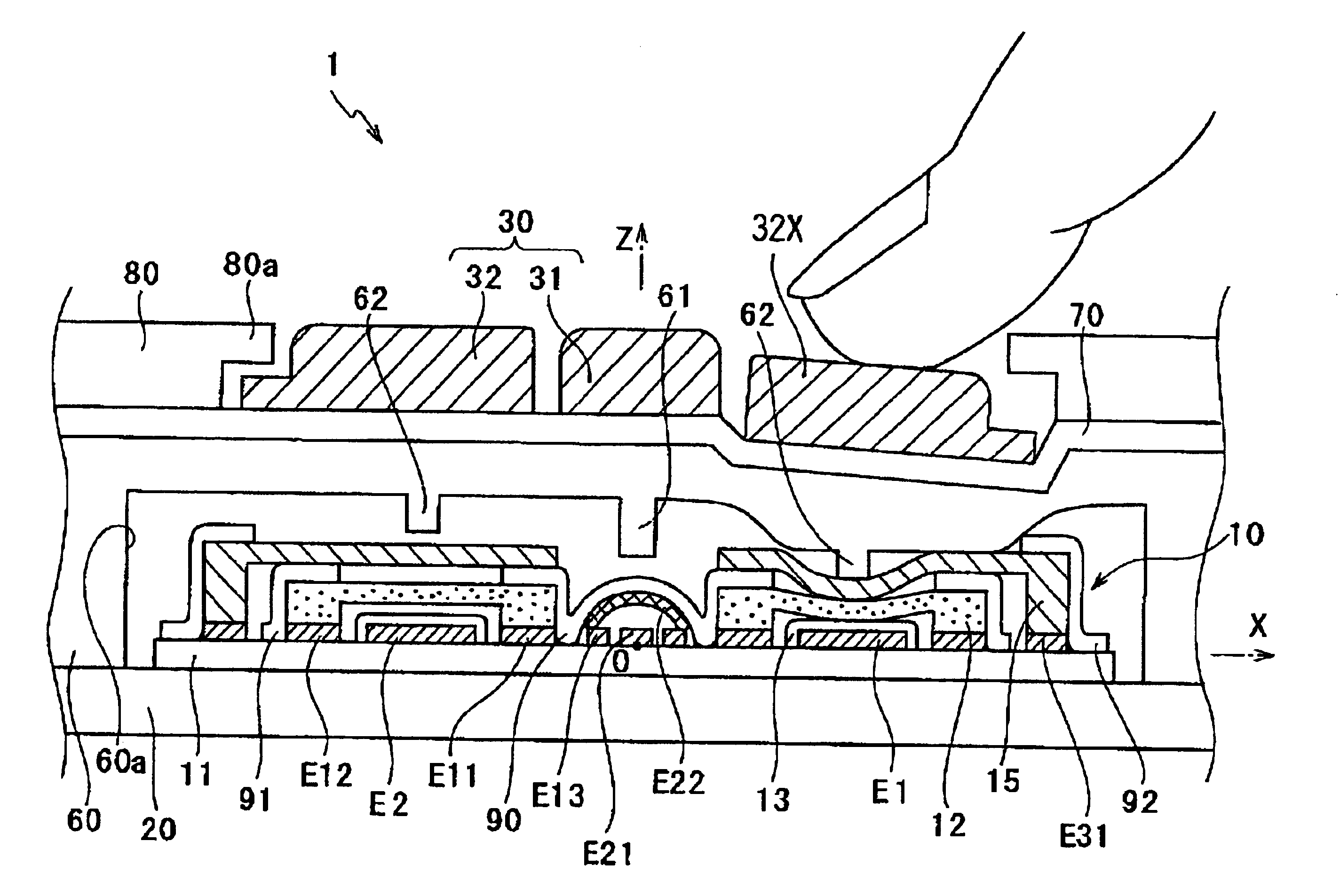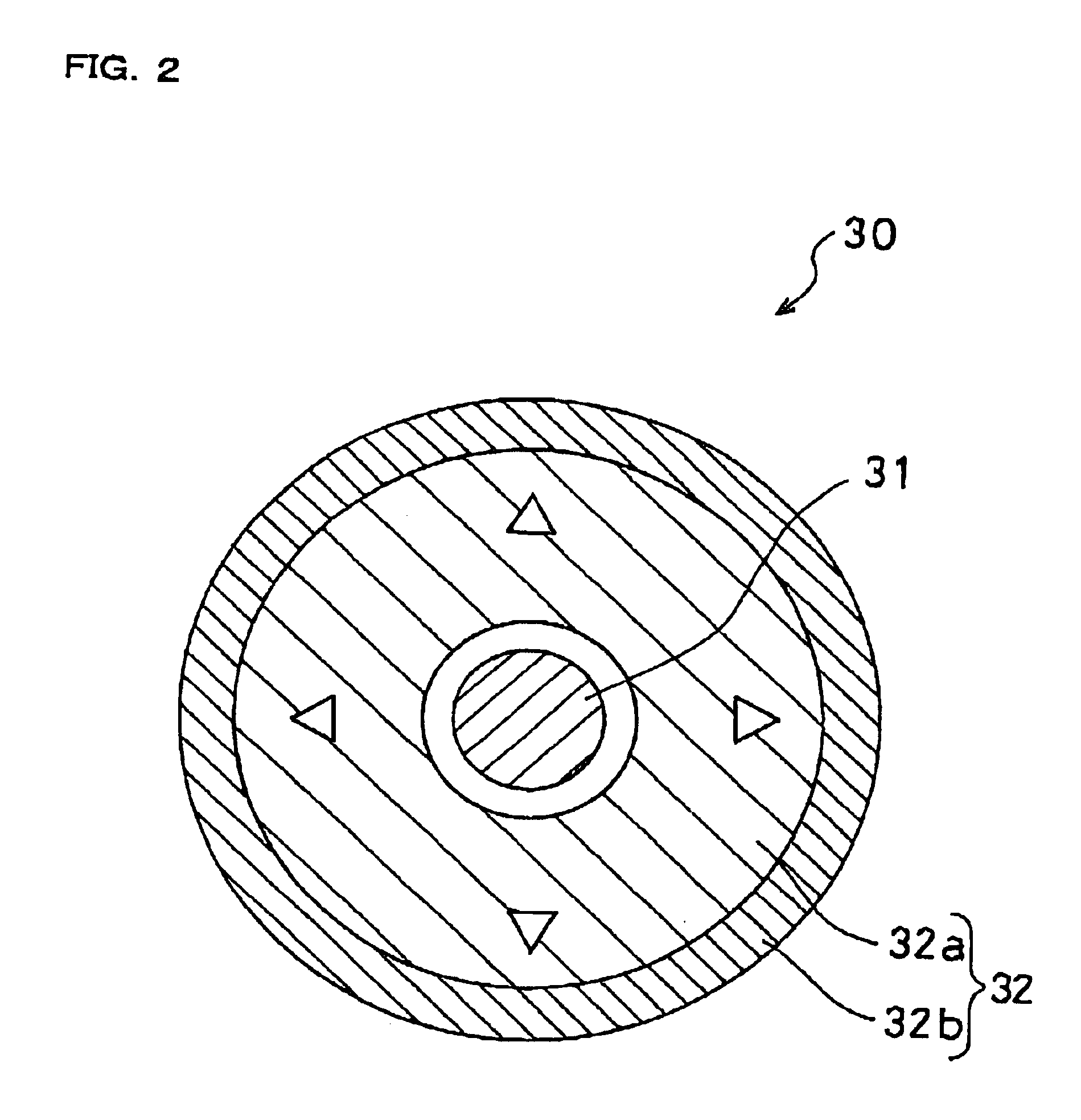Capacitance type sensor and method for manufacturing same
a technology of capacitive type and sensor, which is applied in the direction of stringed rackets, instruments, force/torque/work measurement apparatus, etc., can solve the problems of wasting power, difficulty in realizing the reduction of consumption power, and inability to properly cancel sleep mode, etc., to achieve the effect of reducing power consumption
- Summary
- Abstract
- Description
- Claims
- Application Information
AI Technical Summary
Benefits of technology
Problems solved by technology
Method used
Image
Examples
first embodiment
[0095]Now explanation is made on the structure of a capacitance type sensor 1 according to the present invention, with reference to FIGS. 1 to 3.
[0096]FIG. 1 is a cross-sectional view of the capacitance type sensor 1 according to the present embodiment. The capacitance type sensor 1 includes a substrate 20, a detection button 30 for detecting a force externally applied, a supporting member 60 fixingly supporting the detection button 30 on the substrate 20, a resin sheet 70 disposed between the detection button 30 and the supporting member 60, a sensor unit 10 arranged between a recess 60a formed generally rectangular in an underside of the supporting member 60 and the substrate 20, and a cover case 80 formed for example of a resin covering around the detection button 30 on an upper surface of the resin sheet 70.
[0097]The substrate 20 is a usual printed circuit substrate for an electronic circuit, which in this embodiment employs a glass epoxy substrate. The substrate 20 may use a fi...
second embodiment
[0177]Now explanation is made on the structure of the capacitance type sensor 201 according to the invention with reference to FIGS. 17 to 19.
[0178]FIG. 17 is a cross-sectional view of a capacitance type sensor according to this embodiment, being shown correspondingly to the first embodiment of FIG. 1. The difference in structure of the capacitance type sensor 201 of this embodiment from the capacitance type sensor 1 of the first embodiment of FIG. 1 lies in the following. Namely, the sensor unit 10 of the first embodiment has one return-switch movable electrode 15 whereas the sensor unit 210 of this embodiment has two return-switch movable electrodes E215, E216. Furthermore, the return-switch movable electrode 15 of the first embodiment is connected with the return-switch fixed electrode E31 whereas the two return-switch movable electrodes E215, E216 of this embodiment are respectively connected with separate return-switch fixed electrodes E231, E232. The other structure is nearly ...
third embodiment
[0210]Now explanation is made on a capacitance type sensor according to the invention, with reference to FIGS. 22, 23A, 23B and 24. FIG. 22 is an external perspective view of a capacitance type sensor 301 according to this embodiment, FIG. 23A is a cross-sectional view on line V—V of the capacitance type sensor 301 of FIG. 22, and FIG. 23B is an arrangement view showing the electrodes on a substrate of the capacitance type sensor 301 of FIG. 22. FIG. 24 is a circuit diagram showing an equivalent circuit concerning the capacitance type sensor 301 of FIG. 22.
[0211]Although the detection button 30 of the foregoing first and second embodiments is configured by a plurality of members, i.e., central button 31 and direction button 32, the detection button 330 in this embodiment is configured by a single member as suitably shown in FIG. 23A. The detection button 330 of this embodiment is accommodated, for play-fit, within a hollow housing of cover case 380, e.g., of resin. This has a projec...
PUM
| Property | Measurement | Unit |
|---|---|---|
| capacitance | aaaaa | aaaaa |
| distance | aaaaa | aaaaa |
| tensile force | aaaaa | aaaaa |
Abstract
Description
Claims
Application Information
 Login to View More
Login to View More - R&D
- Intellectual Property
- Life Sciences
- Materials
- Tech Scout
- Unparalleled Data Quality
- Higher Quality Content
- 60% Fewer Hallucinations
Browse by: Latest US Patents, China's latest patents, Technical Efficacy Thesaurus, Application Domain, Technology Topic, Popular Technical Reports.
© 2025 PatSnap. All rights reserved.Legal|Privacy policy|Modern Slavery Act Transparency Statement|Sitemap|About US| Contact US: help@patsnap.com



